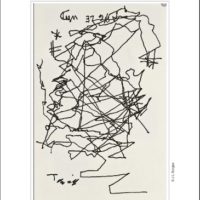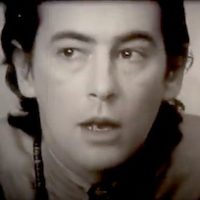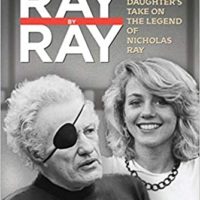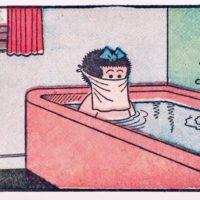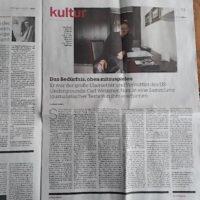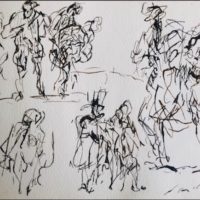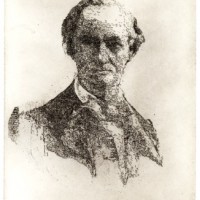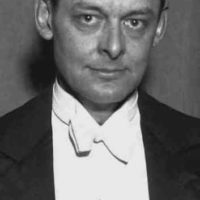“We are in this together. We are stronger together.”
It’s Covid Time in Times Square and in the not united U.S. of A.
Borges: ‘The Thing I Am’
‘I have forgotten my name. I am not Borges
(Borges died at La Verde, under fire)
Nor am I Acevedo, dreaming of battle . . .
On the Other Side of the Pond, Locking Boris Down
David Eros responds to the U.K. prime minister’s lockdown speech.
Music for All Seasons: Little Richard Meets Vivaldi
Wouldn’t it be grand?
Michael McClure, R.I.P.
Dead at 87, he was foremost a poet, but also a playwright, essayist, and novelist.
‘A Daughter’s Take on the Legend of Nicholas Ray’
Three Rooms Press has just published RAY BY RAY, a combination memoir-biography by Nicca Ray, daughter of the maverick Hollywood director Nicholas Ray, with an introduction by Samantha Fuller, daughter of another Hollywood maverick, the screenwriter/director Sam Fuller. The publisher will present a livestream book launch Saturday afternoon—May 9 @ 2pm-4pm EST — featuring the […]
Nancy Masks Up in Her Bathtub
She’s taking no chances. Gary Lee-Nova has been exploring Bushmiller’s work for many years. This particular effort originated in an email exchange with Denis Kitchen who founded Kitchen Sink Press. Kitchen Sink published five volumes of Bushmiller’s work during the 1980s and ’90s. “We’ve been internet pals for several years,” Lee-Nova says. During the early […]
Inside the CUNY Graduate Center: A Dissertation Showcase
On Tuesday, May 19 at 7:30 p.m., six doctoral students from diverse disciplines will make short video presentations, describing their research in three minutes each. Topics include increasing the efficiency of solar energy, the Black Panthers’ contributions to education, the effectiveness of anti-corruption laws in the U.K. and the U.S., the figure of the “surrogate mother” in American theater and film, how philosophy can improve policing, and the importance of seeds in evolution. See how, even while students can’t physically come to campus, the intellectual life of The Graduate Center continues to thrive.
GC CUNY Keeps the Conversation Going:
‘The Future of Health Care’ featuring Margot Sanger-Katz, Jonathan Gruber, Avik Roy, and Dana Singiser; also the Eminent Author Anne Carson on Greek Tragedy
While events are postponed at The Graduate Center of the City University of New York in the heart of Manhattan, videos of recent public programs from its archive will be featured here for your enjoyment. The videos offer illuminating discussions in two main categories: insights into current events and conversations with leading writers and artists.
Carl Weissner at the Top of His Game
He was the great German translator and agent of the U.S. underground. Now his collected journalism is being published.
A Lesson in the Art of Drawing: ‘Taking the Line for a Walk’
The point of the exercise is to wean the young artist off result-oriented copying from photos. ‘Taking the line for a walk’ lets the drawing come about in the process of drawing. The idea is to reduce line to tonal value as opposed to a fixed continuous outline that wraps around the form like a piece of copper wire. The reason is that light on any object will obviously break the outline (contour). The exercise of copying a Daumier sketch is to work with different values of ink and proceed as one would with a sketch.
GC CUNY Keeps the Conversation Going:
Andrew Yang, Leslie McCall, and Richard Reeves
on Capitalism and Democracy; also,
Authors Julia Alvarez and Elizabeth Acevedo
on Craft, Legacy, and Literature
While events are postponed at The Graduate Center of the City University of New York in the heart of Manhattan, videos of recent public programs from its archive will be featured here for your enjoyment. The videos offer illuminating discussions in two main categories: insights into current events and conversations with leading writers and artists.
Before April Slips Away
A friend who lives deep in the French countryside was listening to the radio the other day when she heard a poem by Baudelaire, called “Avril.” She spent the entire day trying to trace it and finally emailed Radio France to ask where she could read it. The answer came. But there’s a surprising kicker.
GC CUNY Keeps the Conversation Going:
Racism and Democracy; also biographer
David Nasaw on the moguls Joseph P. Kennedy,
Andrew Carnegie, and William Randolph Hearst
While events are postponed at The Graduate Center of the City University of New York in the heart of Manhattan, videos of recent public programs from its archive will be featured here for your enjoyment. The videos offer illuminating discussions in two main categories: insights into current events and conversations with leading writers and artists.
Just an Arbitrary Notion
for a useful meaning
no starched collar
inked his lines
nor the uptight
narrowness
of the familiar
bank clerk
Coping With the Shitstorm #6
Music for a Sunday morning.
From a Diary #2
Heavy snow took down the internet, which came back up just now . . . will the power lines go down ? . . . the snow is still falling . . . fingers crossed . . . beautiful to look at though, and the two grandkids will go sledding . . . hear from a friend in Berlin that the sun is out there . . . and so are the sun worshippers . . . plenty of ambulance sirens too . . . no sun here, much less worshippers . . . as to sirens, I haven’t heard one in four weeks . . . glad of that . . . even in normal times they were a regular sound track back in the city . . .


